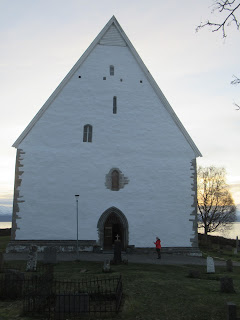Harstad to Sortland in the Lofoten Islands
We arrive during breakfast at Harstad and I disembarked. I was taking a tour that would finish in Sortland. Meanwhile the ship would leave Harstad, call at Risøyhamn and continue to Sortland where, if everything went to plan, I would rejoin the ship.
After a drive through the streets of Harstad with various public buildings, university, squares and other places of interest being pointed out, we left the town centre and headed to the historical centre of Trondenes located on the peninsula north of Harstad. Here is the most northerly stone built medieval church. The south facade.The north facade.
The west door.
The separate belfry facing the west door.
A memorial to the Soviets soldiers who fell in the liberation of northern Norway.
One of two watch towers looking out over then fjord at the east end of the church.
Next visit was to the Trondenes Historical Centre. Here they have recreated a turf home to show visitors how their ancestors lived.
The entrance.
Our local guide.
The single room inside the turf covered house. The family would sleep on the benches and the too acted as a playroom, workshop and home and everything happened in this one room. Cooking, clothes making, woodwork,etc.
The wooden church. There was a church here long before the stone built church just along the shore but its east location is not known.
Inside the wooden church, although the insides have not yet been completed as it is still a work in progress.
High on the hill overlooking the turf house is the black smith shop, always built away from other buildings due to the fire hazard.
Inside the blacksmith's shop.Looking back at the turf house.
Some of the plants grown in the garden for the family.
The layers of turf, laid in a zig zag pattern seen in many turf houses.
The chicken coop.
A hay stack.
Flax drying, used for clothes, rope and many other uses.
At the far end of the peninsula is the Trondenes Fort, built by Soviet prisoners of war who were held in appalling conditions. It was finished just as the Germans retreated so the guns had been installed but were never fired.
Then it was a scenic coach drive across the island to a fjord with an island in the middle of it called in Kvæoya in Kvæfjord and don't be fooled by the sun shining on the snow in the distance....
Then it was a scenic coach drive across the island to a fjord with an island in the middle of it called in Kvæoya in Kvæfjord and don't be fooled by the sun shining on the snow in the distance....

...it is minus four degrees centigrade outside.
Another view of the Kvæfjord.
Water cascading into the fjord at Vik...
...and you just about make out the turbulence as it rushes into the fjord.
We reached the ferry across Gullesfjord from Refines to Flesnes and were treated to coffee, a waffle with some sweet brown Norwegian cheese which has a caramel flavour and lease, a folded flatbread with a sweet filling.
A view of the mountains through a porthole.
The vehicles on deck.
The landing stage.
Some of the houses along the fjord.
Troll Mountain, further back up the road, it looks like a troll lying down but there was a lot of reflection on the glass and when there was less reflection, I had missed the opportunity of taking the troll, just another view of the correct mountain but the wrong angle.
There was a photo opportunity later but there was no troll mountain...
...but there was a quaint shack.
We crossed a pass to reach Sigerfjord.
These house were flattened by an avalanche just a decade ago and several people lost their lives. Now no building is allowed in this area as it is prone to avalanches.
We crossed the bridge that connects two of the Lofted islands on our way to rejoin the ship and as luck would have it, my ship was steaming underneath the bridge as we crossed and the passengers on the from viewing deck waved.
...but there was a quaint shack.
We crossed a pass to reach Sigerfjord.
There used to be a lot of herring here and there was a herring oil processing plant. It needed electricity so in the distance on the left of the photo, there is a pipe coming down the hillside which directed water at pressure into a turbine to generate hydroelectric power, built in 1906.
The herring processing plant is still there but now it produces tarmac and asphalt for roads.
These house were flattened by an avalanche just a decade ago and several people lost their lives. Now no building is allowed in this area as it is prone to avalanches.





































No comments:
Post a Comment